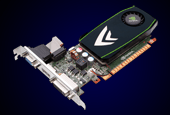With every release of a new DirectX 11 card, there is a surge of hardware articles racing to compare one to another. With the new release of both the Nvidia GT 430 and the GTS 450, the debate has flared up again.
Does this new super cheap GT 430 compare to ATI cards in the same class? Can you even compare the two apples to apples?
ATI has 10 DX11 cards available and they have been around for quite awhile. Comparatively, Nvidia started late and only offered 2: the high-end GTX 480 and GTX 470
.
I guess their strategy involved starting with the best and working their way down. They later released another pair: the mid-end GTX 465 and GTX 460
. This week we saw yet another pair (seeing a pattern here?) in the entry-level GTS 450
and GT 430
.
What it is and what it’s not
Nvidia marketing material says the GT 430 will “level-up your game on the latest DirectX 11 titles.” Well, shame on them. They can’t really say that with a straight face, so they put it in print. The GT430 is not for gaming.
It’s real purpose is three-fold. The first is price point. The second is home theater entertainment. The third is 3D video (glasses sold separately, of course). Before looking at those 3 items, check out the high points of this card:
- Features – Fully supports DirectX 11
- Price – Nvidia’s first DX11 card under $100
- Size – Nvidia’s first DX11 card to use 1 PCI-E slot
- Hookup – VGA, DVI, and HDMI 1.4a
- Experience – Blu Ray 3D and 3DTV Play software
Price Point
I wonder how long it took for them to figure this one out? Until now, Nvidia has ignored the entry-level market. It is unclear whether they wanted to increase the perceived value of their brand like, say, Bose, or they believed this segment of the market was fine with whatever came installed their PC.
Either way, ATI has already offered three cards for for less than $100: the HD5450, the HD5550
, and the HD5570
. They have been gobbling up this entire portion of the market and Nvidia missed the boat.
For this $75-$85 price tag, you won’t be paying for any extra gaming performance, which is a good thing (because you won’t buy this for gaming). You would be buying this card so that you can take advantage of its features, not its horsepower.
Home Theater
Aside from simply having a low price point offering, this card is designed for your home theater PC. As stated in the list up above, this is Nvidia’s first 400 series card that doesn’t take up 2 PCI-Express slots. It is also low profile. That is really big news for Nvidia, but ATI’s entry level cards already offered that.
This size factor is huge for the fancy new boxes that people are buying today for their HTPC (home theater PC). If you have a regular tower case in your living room, it won’t be a benefit.

Beyond the size, this card is geared towards streaming video and video decoding. It has hardware video decode acceleration and full support for TrueHD and DTS-HD audio.
These features can all be carried along the HDMI 1.4a output, which comes standard. 1.4a is an advantage over ATI cards and does the following:
- Allows 2160P resolution
- Offers 100Mb ethernet on cable
- Audio return channel (whatever that means)
- Progressive 3D Over HDMI
- Additional 3D format support based on new broadcast standards
The 3D Experience
Since the re-emergence of 3D over the past couple of years, Nvidia has been on-board. ATI didn’t bother with it and you can’t blame them. It’s probably a bigger gamble than Toshiba’s HD-DVD, and the jury is still out. Even though we are seeing the release of Blu-Ray 3D and 3D flat panel televisions, 3D could still flop.
However, some people simply love it. If you are one of those people, the GT 430 would be a perfect fit for your living room TV (unless you want to play video games in your living room also). The best part about Nvidia 3D Vision is that you don’t need a 3D television to watch 3D content. Most 120Hz panels can handle it. This will allow you to enjoy 3D Blu Ray, 3D pictures (from the new 3D digital cameras), and 3D streaming video (like the latest sporting events).
Should you buy the GT 430?
When to buy this card
- If you are Nvidia all the way and need a HTPC card, buy it
- If you need a HTPC card for 3D entertainment, buy it
- If you want a card with HDMI 1.4a, buy it
Bottom line here is that you get what you pay for. While ATI has entry-level for $10-15 cheaper, it may be worth the small difference to get the latest and greatest features. If you are trying to get into PC gaming, though, you really need to shell out some more money.
Update 4/22/2011: If you are considering purchasing a GT 430, then you might want to take a look at the new GT 520 as well.












I’ve got it, and i’m very pleased on it. I compared it on my configuration with an ati at same class and the nvidia ruined the ati one, an i have an amd cpu so ati should win, but nvidia was the best!
I use it and i’ve got no problems!
I recomand it to you